Step 1: Load Geological Data
To get started in Vulcan GeologyCore, you will need to bring some data in. When you load data into Vulcan GeologyCore, a local copy is created and stored in your project![]() A Vulcan GeologyCore project is a local store of your data. A project is stored physically on disk in a database folder with a .maptekdb extension. Most data that you load into Vulcan GeologyCore is imported as a copy, although some data can be imported as a live link back to the source file(s).. This local copy acts like a snapshot of the data that you can modify without changing the source data. The local copy also helps to ensure consistency during the modelling process as you test different scenarios. As new data becomes available, your geological model can be updated without having to set up any of the process again. When the model is completed, you can publish the data back to the source database.
A Vulcan GeologyCore project is a local store of your data. A project is stored physically on disk in a database folder with a .maptekdb extension. Most data that you load into Vulcan GeologyCore is imported as a copy, although some data can be imported as a live link back to the source file(s).. This local copy acts like a snapshot of the data that you can modify without changing the source data. The local copy also helps to ensure consistency during the modelling process as you test different scenarios. As new data becomes available, your geological model can be updated without having to set up any of the process again. When the model is completed, you can publish the data back to the source database.
Loading data for geological modelling
Drillholes are the main data source for generating geological models. You can load drillhole information into Vulcan GeologyCore from a variety of sources, including:
-
Vulcan Isis drillhole databases (*.isis)
-
Vulcan ODBC link drillhole databases (*.dsf)
-
Comma-separated values (CSV) files (*.csv)
You can also load other data, including:
-
Legends—for colouring drillholes or block models by attribute.
-
Composites—which can be used to generate an implicit or DomainMCF model. If your drillholes already have domains defined and composites created, you can go straight to Step 4: Generate a Model.
-
Triangulations—which can be used to limit the scope of your geological model, help define your domains, or to aid in manual interpretation.
-
Design Data—for comparing to your geological model or preparing limits for your drillhole data. Design data has the file extension dgd.isis. Design data can also be used as interpretive data when implicit modelling.
-
Block Model Definitions—for defining model extents when generating a geological model with the Modelling Manager or DomainMCF modelling.
These key data types used in geological modelling can be efficiently loaded into Vulcan GeologyCore at any time using the ![]() Load Vulcan Data tool, located in the Data group on the Home, Modelling, DomainMCF and Stratigraphic ribbon tabs. The tool automatically detects relevant data in your Vulcan project folder.
Load Vulcan Data tool, located in the Data group on the Home, Modelling, DomainMCF and Stratigraphic ribbon tabs. The tool automatically detects relevant data in your Vulcan project folder.

Follow these steps to load geological data into Vulcan GeologyCore using the Load Vulcan Data tool:
-
Launch the Load Vulcan Data tool and select the files to import.
-
Click
 Load Vulcan Data on the ribbon.
Load Vulcan Data on the ribbon.The Load Vulcan Data panel appears.

Relevant files found in the data folder are automatically listed in each file type section.
-
Select the files you wish to import.
-
Click
 on a file to remove it from the list of files to import.
on a file to remove it from the list of files to import. -
Click
 on any list to clear all files from the list.
on any list to clear all files from the list. -
Click
 to the right of any Files field to browse for files to import. Browsing and selecting new files will replace the current file selection.
to the right of any Files field to browse for files to import. Browsing and selecting new files will replace the current file selection.
The Files field in each section lists the files of each type to import.
-
Under Legends, select your Vulcan legend file (*.scd).
-
Under Drillholes, select any number of drillhole databases (*.isis, *.dsf, *.csv) to import.
-
CSV drillhole databases consist of multiple files, each representing the collar, survey, geology or other information about the drillhole set. Select all the CSV files you wish to import—at a minimum this must include the file defining the drillhole collars.
-
In Inclusion file, optionally specify a drillhole selection file (*.sel) to include only a subset of drillholes to be import. A selection file is a text file containing a list of hole names. Names can use an asterisk (*) as a wildcard. Only drillholes with names found or matched in the selection file will be imported. Below is an example of a selection file.
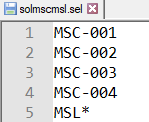
-
In Exclusion file, optionally specify a drillhole selection file (*.sel) to exclude only a subset of drillholes to be imported.
-
-
Under Composites, select any number of Vulcan composite database files (*.isis, *.dsf) to import.
-
Under Triangulations, select any number of triangulation files (*.00t, *.**t) to import.
-
Under Design Data, select any number of Vulcan design data files (*.dgd.isis) or CAD files (*.arch_d) to import.
-
Select the Import as a live link checkbox to import the files as a live link. This means that any changes made to the files in Vulcan will automatically propagate to Vulcan GeologyCore.
-
-
Under Block Model Definitions, select any number of Vulcan block model definition files (*.bdf).
-
-
You can also import other data types not listed in the Load Vulcan Data tool from the Home > Data > Import ribbon menu item. For example, Open Pit blastholes (including multi-interval blastholes) can be loaded into an internal drillhole database from a single collar CSV file.

You can drag and drop the CSV from the Windows Explorer into the viewer directly or use the import option in the Home ribbon.
-
On the ribbon, navigate to Home > Data > Import.
-
On the Import panel, select the CSV file that contains the blastholes and choose import as Drillholes.
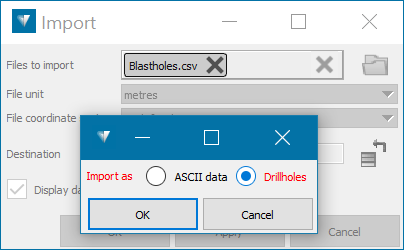
-
Press OK and the Import Drillhole File into a Drillhole Database panel is displayed.

Note: The workflow for importing blastholes is:
- Primary Collar and Survey fields should get auto-populated.
- Any extra Assay or Geology fields can be assigned to the desired drillhole database table by clicking on the column headers.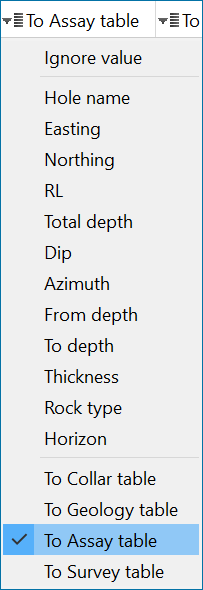
- If all currently undefined fields (denoted by Ignore value in column header) are required to be designated to the Assay table, the All 'Ignore vaue' to Assay button can be used.
- An optional import specification can be saved by using the Save specification as option at the top of the panel.-
Use existing specification: Use the existing named database layout specifications for field-type assignments, coordinate system, units, and storage class. Alternatively, initialise the field-type settings - this will include attempting to predict the field-type if the CSV file has a header line.
-
List only matching specs: Select this option to show only those specifications that match the current data. You may use non-matching specs as a basis for the settings, but you may find that not all column types will be defined, as only the best matched columns will be selected.
-
Save specification as: Save the current settings for field-type assignments, coordinate system, units, and storage class. These will be saved to the name specified.
-
Clear Field-types: This button will clear all assigned field-type settings.
-
Predict Field-types: This button will clear all currently assigned field-type settings and attempt to predict the most suitable field-types for the columns on the basis of their names. Option is only available if there is a column header row on the file.
-
All 'Ignore value' to Geology: This button will assign all fields currently set as 'Ignored value' as fields of the 'Geology table'.
-
All 'Ignore value' to Assay: This button will assign all fields currently set as 'Ignored value' as fields of the 'Assay table'.
-
Drillhole data grid: This is the drillhole data to be imported. Define each of the columns to a field in the drillhole database.
-
Dip angle is in degrees from horizontal: The dip, or vertical, angle is measured in negative degrees from the horizontal. Vertical is -90 degrees.
-
Dip angle is in degrees from vertical: The dip, or vertical, angle is measured in positive degrees from the vertical towards the hole bearing. Vertical is 0 degree.
-
Use the header line field names: Use the column name as shown on the CSV header row for all database table field names. If this is not selected, the standard names will be used for the required fields, and the header names for the other fields if header names are available. If the header is unavailable, the other field names will be the field number in the form 'Field_n'.
-
Use stratigraphic field names for Geology table: Use stratigraphic names for Rock type and Horizon fields. If not selected, these will be Lithology and Formation respectively.
-
Project and Extracted CSV Files: The location and details for the 'project' file associated with database created and also the location of the CSV files extracted from this current CSV file in order to build the database. By default, the location will be a sub-directory of the main 'project' directory, having the same name as the database created.
Note: It is better to have these in a sub-directory for ease of determining the related items.
Project destination: The destination directory for the database 'project' file and the extracted CSV files. Changing this will also change the name of the database destination (but that can be modified if required).
Coordinate system: Select the coordinate system of the drillholes.
Distance unit: Select the distance unit of the imported data.
-
Storage Class
Internal database: The drillholes are copied on import and are independent of the CSV files extracted from the original source that are on the file system. Changes made in the application will have no effect on these external files. Optionally, another table (Intervals Table) may be added to the database for use with the Domain Modelling workflow.
Link to external CSV files: The drillholes are imported and retain a connection to the CSV files extracted from the original source that are on the file system. Any changes made in the application will also change these external files.
-
Destination: Define the name of the container to store the drillholes. Use the
 button to remove leaf component of the selection.
button to remove leaf component of the selection. -
Display drillholes in new view: Select this option to display drillholes in a new view.
-
-
-
-
-
Import selected files.
To import selected files, do one of the following:
-
Click Import n files (e.g. “Import 2 files”) in any given file type section to import only the files listed in that section.
-
Click Import All to import all files listed on the panel.
-
-
Confirm drillhole database import.
If you chose to import a drillhole database, a panel appears where you can configure and confirm the import.
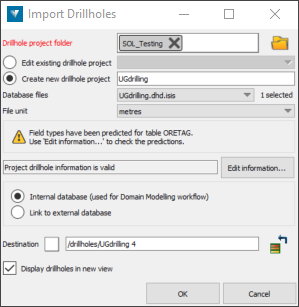
-
Configure the database import settings.
It is recommended to use the default import settings. You can, however, modify the import settings.
Tip: Be sure to select the Internal database radio button if you want to use the Domain Manager to dynamically code domains.

-
Set the location of the drillhole database files next to Drillhole project folder.
-
Choose to edit an existing or create a new drillhole project file.
Drillhole project information such as table and field mappings is stored in a drillhole project file with the extension .maptekdhp in the drillhole project folder.-
Select Edit existing drillhole project to use an existing drillhole project file in the drillhole project folder.
-
Select Create new drillhole project to create a new drillhole project file in the drillhole project folder.
-
-
Edit the set of drillhole database files to import from Database files.
-
Click Edit information... to edit the drillhole project information, such as table and field types and coordinate system information.
If there is an existing drillhole project file (*.maptekdhp) in the drillhole project folder, Vulcan GeologyCore will use it to establish the table and field mappings. If not, Vulcan GeologyCore will attempt to automatically assign mappings. In either case, you can inspect and edit the project information with this tool.
Specifying the coordinate system is optional. You will not need to do this if all the data is in the same coordinate system. Specify a coordinate system if you want to use data from different systems, or if you want to transform data from one system to another.
-
Choose the database type.
-
Select Internal database to create an internal copy of the database within your Vulcan GeologyCore project. An intervals table will be created to store the domains to be modelled. Changes you make to the database within Vulcan GeologyCore will not affect the source files until you explicitly publish.
-
Select Link to external database to use the drillhole database project files directly. Changes made to the drillhole database within Vulcan GeologyCore will be reflected immediately in the database source files.
Important! This option is not recommended as it is not compatible with the domain modelling process.
-
-
Set the path in the project explorer to import the database to next to Destination.
-
Select the Display drillholes in new view checkbox to display the drillholes in a new view when import is complete.
-
-
Click OK to import the data.
The data is imported, and by default is stored in various standard containers within your project.
If you selected the Display imported data in the view checkbox on the import panel, the imported data will be displayed in a view window.
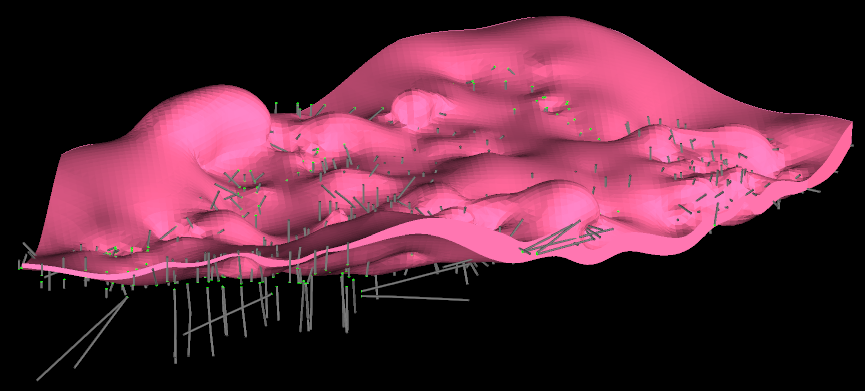
When import is complete, Vulcan GeologyCore automatically performs some consistency checks on the drillhole database, which you can inspect in the report window.
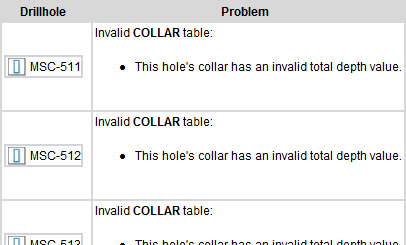
The report is also saved to a CSV file in your data folder.
-
To view the CSV file in the Workbench CSV Editor, drag the file
 from the report window onto the Workbench Start Page tab.
from the report window onto the Workbench Start Page tab. -
To show the CSV file in a Windows file browser, simply click on the CSV file
 in the report window .
in the report window .

In Step 2 of the Vulcan GeologyCore Workflow, you’ll learn how to fix any problems detected.
-
-